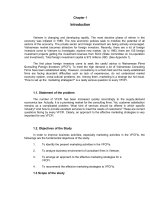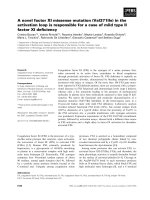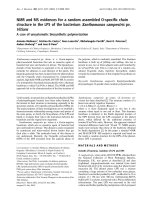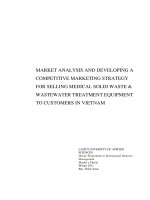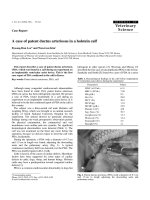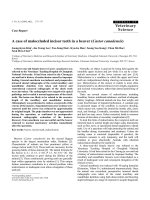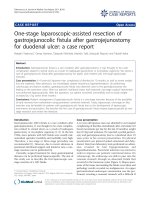Marketing strategy for successful competition A case of SaiGon ground services in 2013 đến 2016
Bạn đang xem bản rút gọn của tài liệu. Xem và tải ngay bản đầy đủ của tài liệu tại đây (2.12 MB, 98 trang )
TRƯỜNG ĐẠI HỌC MỞ TP. HCM UNIVERSITÉ LIBRE DE BRUXELLES
HO CHI MINH CITY OPEN UNIVERSITY SOLVAY BRUSSELS SCHOOL
MBAVB3
LÊ THỊ HỒNG HẠNH
MARKETING STRATEGY FOR SUCCESSFUL
COMPETITION: A CASE OF SAIGON GROUND SERVICES
IN 2013-2016
TUTOR: DR. VO THI QUY
MASTER PROJECT
MASTER IN BUSINESS ADMINISTRATION
(PART-TIME)
Ho Chi Minh City
(2013)
i
COMMITMENT
I hereby, Le Thi Hong Hanh, confirmed that my thesis preparation and the content was
written by myself with information studied and obtained from reliable sources. I
undertake this is my own research project. All information, data and survey results are
true and never announce in any other research projects.
Ho Chi Minh City, 7 April 2013
Le Thi Hong Hanh
ii
ACKNOWLEDGEMENT
First and foremost, I would like to express my gratitude to the support and guidance
from my tutor, Dr.Vo Thi Quy who gave me her continuous guidance during doing the
final project. Without her, my project would not have been completed.
I would like to say thank you to:
- Professors from the Solvay Business School and Open University of HCMC for
all support throughout the whole program.
- Management Board of Open University Ho Chi Minh City who have provided
me a very good condition for studying and sharing ideas.
- All members of MBAVB3 and Group 1 who always encouraged me to share
during the study and implement the final project.
- Mrs Le Thi Thu Ha with her encouragement suggestion and enthusiastic help.
I am special thanks to Mr. Danh who is kindly enthusiastic about supported and
encouraged me throughout the dissertation process. No words could possible to express
deepest gratitude to my beloved family for their inspirational and moral support.
During executing the final project, due to the limitation of experience and knowledge, I
am unable to avoid some mistake. I hope the Professors could help me to improve for
achieving better results in the future.
Finally, I wish you good health and so much success in work and life!
iii
ABSTRACT
Established in 2005, Saigon Ground Services (SAGS) is a subsidiary of Airports
Corporation of Vietnam (ACV). After years of development efforts, SAGS becomes
the dynamic and professional provider of full - range ground services at Tan Son Nhat
International Airport (SGN).
SAGS ambition to become the leader in ground handling services with safety and
international standards, overcome one great competitor which has many years of
experiences - Tan Son Nhat International Airport Ground Services (TIAGS). SAGS
has been continuously improving service quality and applying modern aviation
technology to all operations in order to meet and exceed customers’ expectations.
The project firstly internally assessed company situation, come out what SAGS’s
competitive advantages, what SAGS’s weaknesses to figure out opportunities and
threats in ground handling service sector in Ho Chi Minh City. Following the internal
assess, a qualitative and quantitative survey were conducted to get information from
the market, understand market characteristic, its demand and SAGS’s target customers
needs for setting up marketing strategies for successful competition.
The project also did some research about SAGS’s competitors via external sources to
understand what they are doing well and not well, what is the direction of SAGS for
differentiation strategy should be.
Based on main findings, a proposal differentiation marketing strategies was chosen.
Some recommendations have then been suggested to grow sales and build up brand
name for SAGS.
TABLES OF CONTENT
COMMITMENT i
ACKNOWLEDGEMENT ii
ABSTRACT iii
TUTOR’ C COMMENT iv
TABLE OF CONTENT v
LIST OF ABBREVIATIONS viii
LIST OF FIGURES ix
LIST OF TABLES x
LIST OF PICTURE xi
CHAPTER 1 - INTRODUCTION OF THE PROJECT
1.1. Introduction 1
1.2. Statement of the problem 1
1.3. Purpose of the project 2
1.4. Research methodology 2
1.5. Scope and limitation 4
1.6. Structure of the project 4
CHAPTER 2 – LITERATURE REVIEW 6
2.1. Marketing definition 6
2.2. Marketing strategy and Services marketing mix 6
2.3. Target consumer, market segmentation and positioning 10
2.4. Competitive marketing strategy 12
2.5. Market Analysis 12
2.6. Porter Five Force 14
2.7. Competitive advantages 19
2.8. SWOT analysis 21
CHAPTER 3 – MARKET ANALYSIS AND RESEARCH FINDING 22
vi
3.1. Market analysis 22
3.1.1. Market size 22
3.1.2. Market growth rate 23
3.1.3. Industry cost structure 26
3.1.4. Market trends 27
3.1.5. Key success factors 28
3.2. Porter Five Force 29
3.2.1. The threat of entry 29
3.2.2. Rivalry among the industry competitors 29
3.2.3. Threat of substitutes 30
3.2.4. Bargaining power of suppliers and buyers 30
3.3. Macro environment analysis - PEST Analysis 31
3.3.1. Political 31
3.3.2. Economic 32
3.3.3. Social 32
3.3.4. Technology 33
3.3.5. Legal 34
3.3.6. Geographic and demographic 35
3.3.7. Summary of company’s opportunities and threats 35
3.4. Micro environment analysis 36
3.4.1. Company overview 36
3.4.2. SAGS’s customers 38
3.4.3. Human resource 40
3.4.4. Marketing 41
3.4.5. Price policy 43
3.4.6. Financial 44
3.4.7. Investment 46
vii
3.4.8. Research and development 46
3.4.9. Summary of company’s strength and weakness 47
3.5. Competitive capacity 48
3.6. SWOT analysis 49
3.7. Result and discussion of customer survey 50
3.7.1. Qualitative research 50
3.7.2. Quantitative research 51
CHAPTER 4 – MARKETING STRATEGY OF SAGS IN YEAR 2013-2016
4.1. Marketing strategy 59
4.1.1. Marketing objective 59
4.1.2. Targeting, segmentation, and positioning 59
4.1.3. Competitive advantages strategy 61
4.2. Marketing Mix 7Ps 61
4.2.1. Product – Services 61
4.2.2. Price 62
4.2.3. Promotion 64
4.2.4. People 65
4.2.5. Place 66
4.2.6. Process 67
4.2.7. Physical evidence 70
CHAPTER 5 – CONLUSSION 72
REFERENCES & APPENDICES 73
viii
LIST OF ABBREVIATIONS
AHM
Airport Handling Manual
IATA
International Air Transport Association
ICAO
International Civil Aviation Organization
IGHC
IATA Ground Handling Council
ISAGO
IATA Safety Audit for Ground Operation
PIR
Property Irregular Report
SAC
Southern Airport Corporation
ACV
Airport Corporation of Vietnam
SAGS
Saigon Ground Services
TIAGS
Tan Son Nhat International Airport Ground Services
SASCO
Southern Airports Services Company Limited
SGHA
IATA Standard Ground Handling Agreement
SLA
Service Level Agreement
CAAV
Civil Aviation Administration of Vietnam
CAA
Civil Aviation Authority
SGN
IATA 3 letter code of Tan Son Nhat Airport
HCMC
Ho Chi Minh City
ix
LIST OF FIGURES
Figure 2.1. Services marketing mix 8
Figure 2.2. A model for structural analysis 17
Figure 2.3. Porter’s Three Generic Strategies 20
Figure 3.1. Market structures of ground handling services sector 22
Figure 3.2. Revenues of ground handling services sector in 2012 23
Figure 3.3. Number of foreign airlines in Ho Chi Minh City 24
Figure 3.4. Number of passengers each year (whole Vietnam) 26
Figure 3.5. Cost structure of Ground services by percentage 27
Figure 3.6. Marketing cost 42
Figure 3.7. Growth rate of cost and profit over 4 years 45
Figure 3.8. SAGS’s key performance 2009 – 2012 45
Figure 3.9. SAGS’s service capacity 56
x
LIST OF TABLES
Table 2.1. Power of suppliers and buyers 18
Table 3.1. Number of airlines over 8 years 24
Table 3.2. Number of passengers 2003 – 2012 25
Table 3.3. Cost structure of Ground services 26
Table 3.4. Rate of Marketing cost/profit 43
Table 3.5. SAGS’s Financial Performance 2009 – 2012 44
Table 3.6. Level of SAGS’s Managers 48
Table 3.7. SWOT Matrix 49
Table 3.8. Competitive Profile Matrix 51
Table 3.9. Competition analysis based on key success factors 52
Table 4.1. Marketing objective of SAGS 59
Table 4.2. Customers using SAGS’s ground services 59
xi
LIST OF PICTURES
Picture 3.1. SAGS’ s full range partners 39
Picture 3.2. SAGS’ s ramp partners 39
Picture 3.3. SAGS’ s freighter partners 40
Picture 3.4. SAGS’ s non-schedule partners 40
Picture 3.5. SAGS’ s website 41
Picture 4.1. Some physical evidence of SAGS 70
1
CHAPTER 1 - INTRODUCTION OF THE PROJECT
1.1. INTRODUCTION
Saigon Ground Services (SAGS) was established in 2005. They are dynamic and
professional provider of full-range of ground service at Tan Son Nhat Airport. SAGS
establishment marked a major turning point in process of international economic
integration thus ending the monopoly of ground handling service market of Tan Son
Nhat International Airport Ground Services (TIAGS) at Tan Son Nhat International
Airport (SGN). Hence, international airlines have more opportunities to choose their
business partners in providing ground services which promote good quality and
competitive prices.
Nowadays, there are three providers of ground handling services at Tan Son Nhat
International Airport: TIAGS, SAGS and a Ground Handling Team of Jetstar Pacific
Airlines. But TIAGS is the main competitor of SAGS.
From the date of its establishment, SAGS has made great efforts in the development
process. After seven years, SAGS has became a company that supplies the ground
handling services in prestige and quality for many major international airlines such as
United Airlines, AirMekong, Tiger Airways, Asiana Airline,
However, to maintain the existing momentum and continue to increase the market
share and achieve an ambitious plan that SAGS will be a top class services to clients in
providing ground services at Tan Son Nhat Airport, company needs to improve the
organization, management and especially the marketing strategy to achieve the highest
business performance. That is the reason why this thesis “Marketing Strategy for
Sucessful Competition: A Case of Saigon Ground Services in 2013-2016” can work.
1.2. STATEMENT OF THE PROBLEM
2
Although invest extensively since the establishment in 2005, SAGS holds the second
position in the ground handling service. SAGS has not achieved its strategic goal of
becoming the leader in providing ground handling service in Ho Chi Minh City for
foreign airlines. Until 2012, SAGS's market share is still behind its key competitor
(TIAGS). This issue is an important problem that SAGS needs to concern in context of
competitive market today. Many factors affect performance of SAGS, in which
effective marketing strategy may play a vital role.
1.3. PURPOSE OF THE PROJECT
The purpose of this final thesis is to have a deep understanding of current situation of
their brand and competition position with competitor, then build the effective strategies
for marketing activities to improve the sales and build up their brand. The research
question of this thesis is all about how customers (airline corporations) and passengers
who directly using SAGS’s service perceive about SAGS, how they think the company
could improve quality of service. From that the recommendations of marketing
strategies will be provided based on the results of this study.
1.4. RESEARCH METHODOLOGY
Secondary data
Internal source: data from SAGS: financial statement in 2009-2013, price book,
service process and current marketing activities.
External source: all the data was collected from academic source, press, aviation
magazine, aviation statistics in newspapers, airlines customer statistics, airport
authority and previous final project and so on.
Primary data
The primary data was collect from SAGS’s customers and airline’s passengers. Some
data was from internal managers of SAGS.
3
Qualitative:
Using direct interview technique of some reputable managers work within this
industry. Applying clear questionnaires mainly focus on evaluation about SAGS and
TIAGS’s services. Some information was collected by supporting of SAGS’s
marketing department. It’s an in office interview, so all the participants will be free to
exchange information together for the study.
The result shows that:
Highlight:
- Management competences
- Flexibility
- Experience
Low light:
- Brand
- Company size
- Customer base
- Process
For better understanding and quantify the result, we conduct a quantitative survey
which was distributed to 22 people from the airport station of each foreign airlines
representative branch in Vietnam. They are the current customers of SAGS and some
customers from rival company TIAGS. Besides that, we also collect the idea from over
100 passengers who are directly provided our services.
Quantitative:
1- Survey for our customers from 22 airport station and airlines representative
branch in Vietnam.
4
2- The survey questionnaire was composed and distributed to many direct
passengers using the SAGS’s services who really involved in ground handling
services. The size for sampling is 102 people with 15 questions.
After finding out the issues of SAGS’s operation, there are some discussions and
recommendations of marketing strategy will be proposed. For more detail about the
survey, please prefer to annex portion.
1.5. SCOPE AND LIMITATION
Due to limited capacity of the author and the lack of time of the study, this project only
mentions the following aspects:
- This project only focus on the customers who are foreign airlines representative
doing business in Ho Chi Minh City.
- The competitor information such as price, process, and technical equipments are
collected very hardly because of business secret.
- The Interviewees in Qualitative research are related to the managers of the
SAGS’s customers and rival customers that can make the decision to choose the
services supply organization. It is specifically the person holding important
positions in the organization such as board of director and marketing or business
managers. However, all of them are usually busy so the questionnaire is limited
to a short respond period and cannot be constructed to explore complex issues
relating to marketing strategy of the company.
1.6. STRUCTURE OF THE PROJECT
The structure of the project includes 5 chapters.
Chapter 1 – Introduction
5
Take a general view of final project, determine marketing problem and give out the
reason why the study exist. The introduction also states the methodology that used in
this study.
Chapter 2 - Literature review
This chapter would define the theoretical background which be applied in the final
project. It provides key conceptual definitions of marketing strategy, market analysis,
market structure, competitive analysis, Porter Five Force, competitive advantages,
Competitive competency, competitive marketing strategy, SWOT analysis. Most of
them are referred from academic resources
Chapter 3 - Market analysis and finding
This chapter generally analyzes the current status of business environment, the market
trend of SAGS. All information had been analyzed in detail according to the data
collected. Then find out the issues of marketing strategy which company should be
upgraded and what could be done in the near future in other to maintain present
customers, attract the new one and becoming a leading company in ground handling
service market, beat the main competitors TIAGS in the next three years.
Chapter 4 - Marketing strategy of SAGS in year 2013-2016
This chapter presents some presents marketing mix strategy in detail in the next 4
years, form 2013 to 2016. It includes the marketing strategy of services, place, price,
promotion, physical evidence, process and people. It also gives the recommendations
to support the solutions for upgrading the marketing activities and management more
effectively.
Chapter 5 – Conclusion
6
CHAPTER 2 – LITERATURE REVIEW
2.1. Marketing definition
Marketing is not solely advertising or selling. Real marketing is less about selling and
more about knowing what to make (Philip Koler, 1999, p.9).
Marketing is the delivery of customer satisfaction at a profit. The goal of marketing is
to attract new customers by promising superior value, and to keep current customers by
delivering satisfaction. Therefore, marketing must be understood not in the old sense of
making a sales-“selling”- but in the new sense of satisfying customer needs.
The marketing concept holds that the key to achieving organizational goals consists of
the company being more effective than its competitors in creating, delivering, and
communicating customer value to its chosen target markets.
The marketing management is as the analysis, planning, implementation and control of
programs designed to create, build and maintain beneficial exchanges with target
buyers for the purpose of achieving organizational objectives. Thus, marketing
management involves managing demand, which in turn involves managing customer
relationships.
2.2. Marketing strategy and services marketing mix:
2.2.1. Marketing strategy:
Marketing strategy is a process that can allow an organization to concentrate its
resources on the optimal opportunities with the goals of increasing sales and achieving
a sustainable competitive advantage (porter 1984). Marketing strategy includes all
basic and long-term activities in the field of marketing that deal with the analysis of the
strategic initial situation of a company and the formulation, evaluation and selection of
market-oriented strategies and therefore contributes to the goals of the company and its
marketing objectives.
7
Marketing Objective: For firms to have a formulation of marketing strategy, they
should have a marketing objective. Objectives include maximization of profit,
maximization of market share, and maximization of sales, enhance brand image,
improve customer satisfaction, provide customer value, and maintain price stability.
Focus: It is recommended for a marketing strategy to have customer orientation and
competitor focus. It is also sometimes called market orientation
Domain: The domain of decision making for marketing strategy includes the
following: (1) market selection, (2) positioning/ differentiation, (3) market entry / exit /
timing, (4) product, price, place, promotion, (5) functional offering of the product.
Market selection involves deciding which customer segments the firm will serve,
which functions of those customer segments will be supported, the technologies that
will be used to provide or support the functions. Positioning is the central theme of a
brand/ product around which the marketing mix elements of product, price, place, and
promotion are selected. Market entry/ exit decisions can be based on market
attractiveness, competitive position or advantages and extent of risk involved in the
market.
Prerequisites: Three prerequisites are recommended to the formulation of marketing
strategy. The first is there should be an organizational opportunity for the product or
service under consideration. This entails existence of market size, reasonable strength
of buyer need, manageable risk of market and the ability of the firm to meet the key
success factors of the market. The second is that the marketing strategy should be
dovetailed with the vision and values of the organization. A high quality firm may
find it difficult to introduce low quality, low cost products. The third prerequisite is
that contingency should be built for the marketing strategy formulated.
Functionality: The different functions that marketing strategy has to perform include
(a) strategic decision making (b) dynamic adjustments to competition and market (c)
8
resource allocation in marketing (d) action setting (e) relationships with key publics. It
is this last function that stresses the importance of the role of relationship marketing in
competitive marketing strategy. It has been postulated that marketing strategy is a
product of marketing relationships, marketing offerings, marketing timing, resources
allocation (Sudarshan D, 1995). He states that relationships for a key component of
marketing strategy. Each relationship is defined by the identity of partner public
(customers, channels) and the contract with it (nature of the relationship).
2.2.2. Services marketing mix:
The service marketing mix is also known as an extended marketing mix and is an
integral part of a service blueprint design. The service marketing mix consists of 7 P’s
as compared to the 4 P’s of a product marketing mix. Simply said, the service
marketing mix assumes the service as a product itself. However it adds 3 more P’s
which are required for optimum service delivery.
Figure 2.1. Services marketing mix
(Source: Marketing Professional Services” By Philip Kotler)
The product marketing mix consists of the 4 P’s which are Product, Pricing,
Promotions and Placement. These are discussed in my article on product marketing
mix – the 4 P’s.
9
The extended service marketing mix places 3 further P’s which include People, Process
and Physical evidence. All of these factors are necessary for optimum service delivery.
Let us discuss the same in further detail.
Product – The product in service marketing mix is intangible in nature. Like physical
products such as soap or a detergent, service products cannot be measured. Tourism
industry or the education industry can be an excellent example. At the same time
service products are heterogeneous, perishable and cannot be owned. The service
product thus has to be designed with care. Generally service blue printing is done to
define the service product.
Place - Place in case of services determine where is the service product going to be
located. The best place to open up a petrol pump is on the highway or in the city. A
place where there is minimum traffic is a wrong location to start a petrol pump.
Similarly a software company will be better placed in a business hub with a lot of
companies nearby rather than being placed in a town or rural area.
Promotion – Promotions have become a critical factor in the service marketing mix.
Services are easy to be duplicated and hence it is generally the brand which sets a
service apart from its counterpart.
Pricing – Pricing in case of services is rather more difficult than in case of products. If
you were a restaurant owner, you can price people only for the food you are serving.
But then who will pay for the nice ambience you have built up for your customers?
Who will pay for the band you have for music? Thus these elements have to be taken
into consideration while costing. Generally service pricing involves taking into
consideration labor, material cost and overhead costs. By adding a profit mark up you
get your final service pricing. You can also read about pricing strategies.
Here on we start towards the extended service marketing mix:
10
People – People is one of the elements of service marketing mix. People define a
service. In case of service marketing, people can make or break an organization. Thus
many companies nowadays are involved into specially getting their staff trained in
interpersonal skills and customer service with a focus towards customer satisfaction. In
fact many companies have to undergo accreditation to show that their staff is better
than the rest.
Process – Service process is the way in which a service is delivered to the end
customer. On top of it, the demand of these services is such that they have to deliver
optimally without a loss in quality. Thus the process of a service company in delivering
its product is of utmost importance. It is also a critical component in the service
blueprint, wherein before establishing the service, the company defines exactly what
should be the process of the service product reaching the end customer.
Physical Evidence – The last element in the service marketing mix is a very important
element. As said before, services are intangible in nature. However, to create a better
customer experience tangible elements are also delivered with the service. Several
times, physical evidence is used as a differentiator in service marketing. Imagine a
private hospital and a government hospital. A private hospital will have plush offices
and well dressed staff. Same cannot be said for a government hospital. Thus physical
evidence acts as a differentiator.
This is the service marketing mix (7Ps) which is also known as the extended marketing
mix.
2.3. Target customer, market segmentation and positioning
2.3.1. Target customer
To succeed in today's competitive market place, companies must be customer centred -
winning customers from competitors by delivering greater value. However, before it
11
can satisfy consumers, a company must first understand their needs and wants. So,
sound marketing requires a careful analysis of consumers.
Companies know that they cannot satisfy all consumers in a given market - at least, not
all consumers in the same way. There are too many kinds of consumer with too many
kinds of need, and some companies are in a better position to serve certain segments of
the market. As a consequence, each company must divide the total market, choose the
best segments and design strategies for profitably serving chosen segments better than
its competitors do. This process involves five steps: demand measurement and
forecasting, market segmentation, market targeting, market positioning and competitive
positioning.
2.3.2. Market segmentation
If the demand forecast looks good, the company next decides how to enter the market.
The market consists of many types of customers, products and needs. The marketer has
to determine which segments offer the best opportunity for achieving company
objectives. Consumers are grouped in various ways based on geographic factors
(countries, regions, cities); demographic factors (sex, age, income, education);
psychographic factors (social classes, lifestyles); and behavior factors (purchase
occasions, benefits sought, usage rates). The process of dividing a market into groups
of buyers with different needs, characteristics or behavior, who might require separate
products or marketing mixes, is market segmentation
2.3.3. Positioning
After a company has decided which market segments to enter, it must decide what
'position' it wants to occupy in those segments. A product's position is the place the
product occupies in consumers' minds. If a product were perceived to be exactly like
another product on the market, consumers would have no reason to buy it.
12
Market positioning gives a product a clear, distinctive and desirable place in the minds
of target consumers compared with competing products. Marketers plan positions that
distinguish their products from competing brands and give them the greatest strategic
advantage in their target markets.
2.4. Competitive marketing strategy
Any marketing strategy has to have a marketing objective. Based on the marketing
objective, there are two types of analysis – strategic market analysis and internal
analysis. Strategic market analysis involves customer management and analysis,
market management and analysis, environmental scanning and future building or
scenario planning. Management of relationships with customers and important external
bodies in the market such as dealers, suppliers and the government is an important part
of marketing strategy formulation and management. Internal analysis includes
strengths, weaknesses, core competencies, resource constraint analysis.
Based on the marketing objective, strategic market analysis, internal analysis (and past
performance records and present strategy), the marketing strategy for a particular
decision problem or situation is developed. This includes the decisions on the 4Ps
(Product, Price, Promotion, Place) or 7Ps with services company. During the process of
marketing strategy development, an analysis of competition and other analytical inputs
of the market are used. The competitive marketing strategy developed is so
implemented and any deviations from the plan are feedback to the marketing objectives
and the development of marketing strategies.
2.5. Market Analysis
The goal of a market analysis is to determine the attractiveness of a market and to
understand its evolving opportunities and threats as they relate to the strengths and
weaknesses of the firm.
13
David A. Aaker is the author of Building Strong Brands, 1995, outlined the following
dimensions of a market analysis:
Market size
Market growth rate
Industry cost structure
Market trends
Key success factors
Market Size
The size of the market can be evaluated based on present sales and on potential sales if
the use of the product were expanded. The following are some information sources for
determining market size:
Government data
Trade associations
Financial data from major players
Customer surveys
Market Growth Rate
A simple means of forecasting the market growth rate is to extrapolate historical data
into the future. While this method may provide a first-order estimate, it does not
predict important turning points. A better method is to study growth drivers such as
demographic information and sales growth in complementary products. Such drivers
serve as leading indicators that are more accurate than simply extrapolating historical
data.


